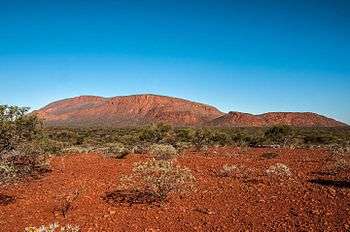Mount Augustus, Western Australia
Mount Augustus (Burringurrah) is located in the Mount Augustus National Park in Western Australia. The name is also given to the neighbouring pastoral lease, Mount Augustus Station. The local Wadjari people call it Burringurrah, after a Dreamtime figure, a young boy who was speared and turned into a rock.[1]

It is a prominent inselberg[2] that stands 1,106 metres (3,629 ft) above sea level, or approximately 860 metres (2,820 ft) above the surrounding plain, and covers an area of 4,795 hectares (18.51 sq mi). It has a central ridge which is almost 8 kilometres (5.0 mi) long.
Monolith–monocline distinction
Mount Augustus is widely claimed in tourist promotional and information literature as the "world's largest monolith",[3][4] but the claim does not originate from the geological literature, nor is it substantiated by any other scholarly research.[5]
Mt. Augustus is more than twice the size of Uluru.[6] Unlike Uluru, which is a monolith and, in general, devoid of plant growth, Mt. Augustus is a monocline (an asymmetrical anticline).
According to the Geological Survey of Western Australia, Mount Augustus is an asymmetrical anticline (rock layers that have been folded into an arch-like structure) which is steeper on its north-eastern side than the south-west.
The rocks consist of sand and gravel that were deposited by an ancient, south-easterly flowing river system that drained the region about 1,600 million years ago. This river system flowed over a faulted and eroded surface of 1,800–1,620 million-year-old granitic and metamorphic rocks. The river deposits consolidated to form sandstone and conglomerate, and were then buried beneath younger marine sediments, which were laid down when shallow seas covered the region between 1,600–1,070 million years ago.
The rocks were buckled into their present-day structure about 900 million years ago when movement along faults in the underlying granitic and metamorphic rocks caused localised, strong, north-east directed compression. The marine sedimentary rocks that overlay the sandstone and conglomerate have since been eroded from Mount Augustus, but now form the hills around Cobra and Mount Augustus homesteads. Erosion has also removed sandstone and conglomerate from the north-western end of Mount Augustus to expose the underlying granitic rocks at The Pound.[7]
Flora and fauna
Wattles, cassias and eremophilas dominate the plant life and the animal life include emus, red kangaroos, goannas, euros and birds of prey.[11] There is over 100 species of birds on and around Mount Augustus.[12]
Walking tracks
The climb to the summit can take up to 5 hours (return) and there are two trails (one class 4 and the other a class 5) to get there. There are a number of walking tracks to explore.[13]
Aboriginal history and rock engravings
Evidence of early Aboriginal habitation is depicted in the rock engravings around Mount Augustus. Many of the Dreamtime stories of the local Aboriginal Wajarri people can be viewed in the rock engravings at Mundee, Ooramboo and Beedoboondu. All of these are accessible on the loop walking trail.[14]
See also
Notes
- https://parks.dpaw.wa.gov.au/park/mount-augustus
- Bourman, Robert P.; Ollier, Cliff D.; Buckman, Solomon (2010). "Mount Augustus Geology and Geomorphology". Geographical Research. 48 (2): 111–122. doi:10.1111/j.1745-5871.2009.00608.x.
- "General Information".
- Tassell, Dave (1978), "Augustus: ancient giant of the west", Australian Outdoors. Yearbook (1978): 114–117, retrieved 11 January 2014
- Bourman, Robert P; Ollier, Cliff; Buckman, Solomon, Dr (1 January 2010), Mount Augustus geology and geomorphology, Research Online, retrieved 11 January 2014CS1 maint: multiple names: authors list (link) – notably in the abstract: Mount Augustus has often been compared with Ayers Rock, and unwarranted claims have been made that it is the biggest rock in the world and the world's biggest monolith. and Other rock types present on Mount Augustus include metamorphic and igneous rocks, which preclude it from being termed a monolith. see abstract –
- "Archived copy". Archived from the original on 24 December 2017. Retrieved 6 November 2016.CS1 maint: archived copy as title (link)
- "Archived copy". Archived from the original on 1 February 2014. Retrieved 18 January 2014.CS1 maint: archived copy as title (link)
- "The Discovery at Mount Augustus". Western Mail (Perth, WA : 1885–1954). Perth, WA: National Library of Australia. 3 February 1894. p. 20. Retrieved 11 January 2014.
- "West Australian Goldfields". Newcastle Morning Herald & Miners' Advocate (NSW : 1876–1954). NSW: National Library of Australia. 18 May 1894. p. 5. Retrieved 11 January 2014.
- "The West Australian Fields". Freeman's Journal (Sydney, NSW : 1850–1932). Sydney, NSW: National Library of Australia. 6 January 1894. p. 20. Retrieved 11 January 2014.
- https://parks.dpaw.wa.gov.au/park/mount-augustus
- "Archived copy". Archived from the original on 24 December 2017. Retrieved 6 November 2016.CS1 maint: archived copy as title (link)
- Western Australia. Dept. of Environment and Conservation (2009), Mount Augustus National Park (Burringurrah) : information and walk trail guide, Dept. of Environment & Conservation, retrieved 11 January 2014
- "Mount Augustus – how to visit the biggest rock in the world". West Australian Explorer. 16 May 2018. Retrieved 6 March 2020.